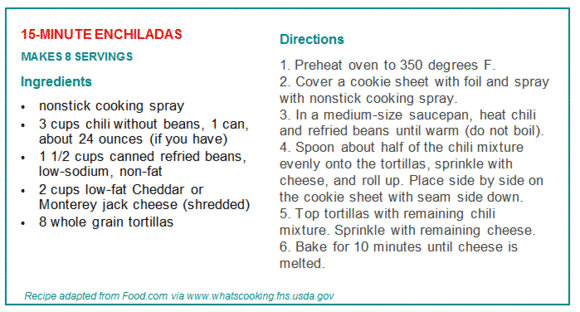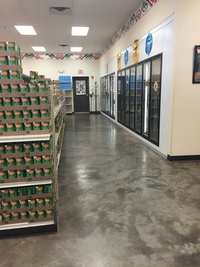 USDA is currently conducting a
shell egg pilot with Seneca Nation in upstate New York with approximately 350
participants on an average monthly basis. The shell eggs are delivered by a produce vendor through the Department of Defense (DoD) Fresh
Fruit and Vegetable Program
(DoD Fresh). Because the pilot has been successful in New York, this year it expanded to
include three Tribes in Oregon: Confederated Tribes of Siletz, Confederated Tribes of Warm Springs, and
Klamath Tribe. Oregon was selected because the DoD contract was amended to
include shell egg distribution. The Indian Tribal Organizations (ITOs) were selected because they have
already been successfully implementing the DoD Fresh program. During the pilot
period, one dozen shell eggs will replace the powdered egg mix participants
receive each month. Each Tribe will work
directly with the DoD produce vendor each month to order shell eggs as part of
its food package benefit. USDA will continue to evaluate this pilot program as
it continues in Seneca Nation and begins in Oregon to consider future expansion to other Tribes. Also, USDA continues to work with DoD to include shell egg distribution in new produce vendor contracts as
well as amending those that are ready for renewal. If you have any questions about the shell egg pilot
expansion, please contact Blair.Tucker-Gruchala@fns.usda.gov for further details.
|
 In Fiscal Year (FY) 2016, USDA
developed and finalized two purchase specifications for wild rice and wild
frozen sockeye salmon fillets, and successfully awarded solicitations for
both items in August 2016. The solicitation for wild frozen sockeye
salmon was awarded to one vendor, Ocean Beauty Seafood. Salmon deliveries
to the national warehouses are expected for late October through the end of
December 2016. The solicitation for Wild Rice was awarded to two Native
American vendors in Minnesota, White Earth Nation and Leech Lake Band of
Ojibwe. Wild rice deliveries to the national warehouses are expected the
second half of October 2016.
In addition, USDA has been successful in receiving offers for
bison deliveries over the course of the next 12 months. Vendors that
received a contract include Intermountain Land & Cattle, Kiva Sun,
and Native American Enterprises. Bison deliveries are anticipated
to begin monthly in October 2016 and last through September 2017.
|
The Cherry Capital of the World hosts Food Distribution!
During the week of June 6, more than 200 attendees gathered
in Traverse City, Michigan, for the 29th National Association of Food Distribution Programs on Indian
Reservation (NAFDPIR) Annual Conference. The conference offered a track of workshops from technology to cooking demonstrations and brought together staff from more than 100 ITOs and State agencies that work closely with FDPIR in certification,
warehouse operations and distribution, and nutrition education. The NAFDPIR Board of
Directors also hosted a luncheon for Tribal leaders
in attendance and Kevin Concannon, Under Secretary of Food, Nutrition and
Consumer Services for USDA. The luncheon provided an opportunity to
discuss program improvements for FDPIR.
View the USDA presentations from NAFDPIR 2016 here!
Mary Ann Helper and NAFDPIR President Joe Van Alstine display one of Mary Ann's star quilts at NAFDPIR 2016.
If you’ve attended one of the NAFDPIR annual conferences in the past 25 years, you’ve likely seen a beautiful, handmade quilt offered as a door prize, and hoped your name would be selected as the lucky winner. Do you know the story behind the quilts? Mary Ann Helper, Certification Technician for the Standing Rock Sioux Tribe’s Food Distribution Program, has been sharing her quilting skills with NAFDPIR since 1991. She began by making one star quilt per conference and now makes two, which she bestows on recipients with the tradition of covering them in the quilt.
Mary Ann has been working with FDPIR for more than 34 years, since July 16, 1982, always in the role of certification. By now, she knows most of the Standing Rock Sioux participants and their life circumstances. She enjoys working with people, going out into the district to certify FDPIR participants, and speaking her tribal language with the older clients. Over the years, two of the major changes to FDPIR Mary Ann has witnessed are the addition of new items to the food package, such as fresh produce and pork chops, and the technological advancements in certification, moving from a typewriter to a computer to complete paperwork.
Mary Ann began sewing in the 1970s, starting out by helping her mother and ultimately learning to make quilts on her own. Her mother would check over her handiwork, and Mary Ann continues to make her quilts with the same dedication as if her mom were inspecting her work. She makes quilts for a number of occasions beyond NAFDPIR, from birthdays and graduations to basketball tournaments. Her repertoire features about thirty, mostly Native designs.
Perhaps her most famous quilt recipient is Phil Jackson, when he was the coach of the Chicago Bulls. Mary Ann’s brother and Jackson attended rival high schools in North Dakota, and her brother beat Jackson’s free throw record by one. Mary Ann decided to make Jackson a quilt and met him in Minnesota to present it to him when his team played the Timberwolves. Her quilts have also been featured in Land’s End catalogs. She started off the quilts with a center design of a star with an eagle, and then the quilts traveled to a West Virginia quilting company for additional pieces and to Alabama for a chain stitch border before ending up in the catalogs.
A widow for three years, Mary Ann has four children; numerous grandchildren, some of whom she raises; and even great-grandchildren. Her son helps her create quilt designs, and a daughter and granddaughter have helped her with hand quilting. Mary Ann’s latest masterpiece was a satin quilt in honor of her late husband’s induction into the softball hall of fame at a powwow in Bismarck, North Dakota, on September 10.
Mary Ann hopes to continue taking quilts to NAFDPIR, and she enjoys creating new designs. Next time you attend the annual conference and see a star quilt on display as a door prize, you’ll know a little more about the star behind the quilts, a woman with a passion for quilting, family, and certifying FDPIR participants.
|
As we head into the fall season, check out two new recipes for Wild Rice Soup and Beef Barley Soup shared by the Menominee Indian Tribe of Wisconsin! Videos demonstrating how to prepare these recipes, and indicating the USDA Foods and other ingredients you'll need, have recently been added to the Recipes & Cookbooks page of the new FDPIR Sharing Gallery.
Interested in contributing recipes or other resources to the Sharing Gallery? Email us at USDAFoods@fns.usda.gov.
|
|
 |
By Kevin Concannon, Under Secretary, Food, Nutrition and
Consumer Services
This February I had the great honor of participating in a meeting on the
landscape of nutrition programs in tribal communities. The meeting in
Washington, D.C. brought together elected leaders from 12 tribal nations across
the country, as well as USDA Acting Deputy Secretary Michael Scuse and
representatives of tribal organizations.
Nutrition wasn’t the only topic on the table that day, as leaders shared with
us the wonders and challenges for those living within tribal communities.
Elected leaders from as far west as Quinault Nation (along the coast of
Washington) to representatives from Little Traverse Bay Band of Odawa Indians in
northern Michigan, spoke of the beauty and tradition among their tribes, but
also shared the challenges experienced by tribal youth, young families, single
adults, and respected elders living on Indian reservations. Read more
A second Tribal leaders meeting occurred on July 12-13 in Oklahoma City, and the next meeting is being scheduled for later this year.
USDA and Tribal leaders meet to discuss nutrition programs in Indian Country.
In August the U.S. Food and Drug Administration (FDA) awarded a $750,000 cooperative agreement to the University of Arkansas at Fayetteville to develop training for tribal operations related to implementation of the FDA Food Safety Modernization Act (FSMA). The goal of the Native American Tribes Outreach, Education, and Training to Enhance Food Safety and FSMA Compliance cooperative agreement is to develop and implement food safety training, education, outreach, and identification of technical assistance resources for key tribal stakeholders, including farmers, packers, and manufacturers/processors that grow, harvest, pack, and hold produce and process food covered by FSMA. Read the full FDA announcement
On July 28, USDA’s Midwest Regional Office hosted a conversation
about food sovereignty and local food systems as part of their Good Greens
partnership. Representatives from Tribal communities and organizations,
including First Nations Development Institute, Oneida Nation, Thunder Valley
Community Development Corporation, College of Menominee Nation, and Navajo
Nation, shared success stories and opportunities to engage communities in
agriculture and enhance local food systems. Community gardens, farmers markets,
and food policy work were discussed. The great work being done by the
presenters was inspiring and hopefully planted seeds for others to implement in
their own communities!

Whole grains are important sources of nutrients such as zinc, magnesium, B
vitamins, and fiber. Whole grain
tortillas are very versatile and can be used in many food preparations including
wraps, burritos, soft tacos, and quesadillas. They can also be cut up and baked
to make a crunchy soup or salad topping. Enjoy this recipe for 15-Minute
Enchiladas today!
|


The season and weather are changing! It is
important for all ITOs to know appropriate techniques
for proper storage of USDA Foods. ITOs must ensure that USDA Foods are stored
in a way that protects them from infestation, spoilage, damage, or other
condition that may jeopardize the wholesomeness and safety of the foods. USDA
Foods must be maintained in sanitary conditions, at the proper temperature and
humidity, and with adequate air circulation. All ITOs must ensure that storage
facilities have obtained all required Federal, State, and/or local health
inspections and/or approvals and such inspections/approvals are current. Planning
ahead will help products maintain their optimal quality and freshness. Dry
storage areas should ideally be maintained at a temperature of 70º F or below
unless other recommended storage directions are provided. Conversely, USDA
Foods placed in a freezer (0º F or below) or a refrigeration unit (40º F or
below) should remain in these storage conditions until they are ready to be
used. For example, in the warehouse or pantry environment, refrigerated storage
for raisins, dried fruit mix, blue cornmeal, and rice is highly recommended.
Temperatures above 70º F in dry storage areas may result in increased insect
activity, such as weevils. Weevils, a type of beetle often found in grain-based
food sources, tend to migrate toward sweet dried fruit once hatched. Please
remember to keep raisins and other dried fruits away from grain-based foods
such as cereals, rice, blue cornmeal, baking mixes, etc. Storage condition
temperatures of USDA Foods should be recorded daily to ensure the integrity of the USDA Foods is maintained, noting any deficiencies
and corrections. By taking the necessary precautions and following purchasing
specifications, food losses can be reduced or prevented.
Are
you interested in specific information on Warehousing of USDA Foods in FDPIR? Review the FNS Handbook 501.
The
Complaint Team is available Monday-Friday, 6:00 a.m. – 5:00 p.m. Eastern Time.
Email USDAFoodsComplaints@fns.usda.gov or call the USDA Foods Complaint Hotline
at 800-446-6991.
|
Certification Workers: This One’s for You!
The FY 2017 FDPIR eligibility standards have arrived! Effective October 1, 2016, please use the updated income standards to determine
if households meet the new income limits for FDPIR. These standards,
listed in Exhibit
M of the FNS Handbook 501, also provide
information on income deductions for the program, including the regional
shelter and utility amounts.
USDA staff had the opportunity to visit several FDPIR sites this summer. Read on to learn more about these programs from Wisconsin to Oklahoma to New York!
USDA
Staff Learn about FDPIR Operations and AIS in Wisconsin
In July, USDA staff visited three
FDPIR operations sites in Wisconsin: Menominee Indian Tribe in Keshena, Oneida Nation in Oneida, and Stockbridge-Munsee
Community in Bowler. These visits
provided opportunities for USDA to learn more about the various methods used
for certification, inventory management, and food package distribution. These visits were part of an ongoing effort
to learn about how different ITOs administer FDPIR and to receive feedback on the
current Automated
Inventory System (AIS) application.
One shortcoming identified in the current AIS is that it
does not offer any tools to assist with the certification process or maintain
detailed client records. Many tribes
rely on manual calculations and paper records. Staff from the Menominee Food Distribution Program and their IT
department demonstrated and discussed an innovative solution they developed to
provide an electronic certification record for each client as well as calculate
adjusted income and deduction totals for the purpose of making a decision on eligibility and choosing an appropriate certification
period.
At the Oneida Nation, USDA staff toured the warehouse and
learned how AIS is used to support inventory management processes throughout
the month from ordering to issuance to end-of-month reports. The warehouse manager provided feedback about
the limitations of the current AIS reports and shared a number tracking forms,
data-entry practices, and other tools and techniques he has developed to
supplement and enhance these reports. USDA staff also received insight from the Food Distribution Supervisor
of Stockbridge-Munsee Community about considerations for ordering and maintaining
inventory at smaller food distribution operations and the importance of strong partnerships
with neighboring tribes.
These observations and feedback as well as ongoing
collaboration with ITOs will guide future development for AIS.
USDA Visits Wichita FDPIR in Anadarko, Oklahoma
In July, Diane Kriviski, Deputy
Administrator for Supplemental Nutrition and Safety Programs, Laura Castro,
Food Distribution Division Director, and Rosa Coronado, Branch Chief for the
Southwest Regional Office Community Nutrition Programs, visited the Wichita
FDPIR in Anadarko, Oklahoma. Beth Parker, the Wichita Director, and her
staff showed us around their “store front,” food storage area, nutrition
education class room, and several gardens funded by the Food Distribution Program
Nutrition Education grants. We were very honored to be invited by the
tribal council to join them for a meeting where we discussed the various food
distribution programs. We also learned about some of the other programs
administered by the Wichita and affiliated tribes, including meals for
seniors. One of the many highlights of our visit was the opportunity to
meet some of the youth who interned with Wichita FDPIR during the summer. We had a great discussion about everything from what they like/don’t like about
school food to the future of FDPIR!

 |
|
USDA Visits Sac and Fox in Oklahoma
USDA staff, Alice McKenney from the National Office and Chris Hennelly from the Southwest Regional Office, visited the Sac and Fox Reservation in Oklahoma in July. Sac and Fox is one of the larger ITOs operating FDPIR, serving on
average 1,900 participants per month. To reach this population, Sac and Fox has two
warehouses, one in Stroud and one in Shawnee. Both distribution sites operate on the grocery store model, which easily allows
participants to follow the program’s pre-made shopping lists and choose which items they would like as part of their food package. Kudos to
the Sac and Fox FDPIR program on all of its efforts to serve the community,
day in and day out!
|
Midwest Region Meets and Visits St. Regis Mohawk Food Distribution
In late August, the FDPIR Midwest Region and Northeast Region tribes held their annual meeting on the Awkwasasne Indian Reservation in Hogansburg, New York. The meeting kicked off with a Nutrition Advisory Committee meeting, open to all and attended by about 20 ITO directors and staff, who provided feedback to the committee.
 In conjunction with this meeting, USDA staff and ITOs also had a chance to visit the St. Regis Mohawk food distribution program. The visit provided a good opportunity to exchange information about products, food storage, shelving, and participation. Nutrition education materials were prominently displayed at the entrance of the warehouse, with recipe books, food models, flyers, and a large FDPIR banner. A tour of the reservation included visiting the elder center, elementary school, and tribal government offices, and entering the Canadian side of the reservation. The meeting continued the next day with presentations and updates from USDA staff members, followed by a cookout and social networking in the evening. The hospitality provided by Sharon Thompson, Lucy Barnes, and the Awkwasasne Tribe was greatly appreciated by all.
|
Update on AIS
Development
In response to concerns raised by
tribes about the inefficiencies of the current Automated Inventory
System (AIS), USDA is working to update and consolidate functions of the computer systems supporting FDPIR. USDA has defined a
vision for the future AIS that is responsive to these concerns, to include:
- A modern, user-friendly web-based system
- Consolidated data to allow communication between
multiple warehouses
- Multiple (concurrent) user capability
- Mobile solution for remote distribution
(tailgates)
- Solution for rural areas with limited or no
telecommunications capability
- Dedicated Help Desk support
To date, most of the activities have been “behind the scenes,”
laying the groundwork for future development through documentation of the
current application, developing a data migration plan, identifying and
evaluating technology solutions, and creating an acquisition strategy.
USDA has also been engaging with FDPIR operations staff. In addition to the information and feedback
sessions at the 2016 NAFDPIR
and WAFDPIR Conferences, USDA staff has visited a number of ITOs
to gain a better understanding of AIS strengths and shortfalls as they relate
to FDPIR operations. Recent
visits included three tribes in the Green Bay area of Wisconsin, featured in this e-letter, and Choctaw Nation of Oklahoma. USDA plans to visit
additional sites in Western, Mountain Plains, Southwest, and Midwest Regions.
USDA will be working collaboratively with individuals participating
as members of an AIS replacement system committee. They will participate in developing business
and technical requirements for the replacement system for AIS, establishing
priorities for system features, and providing feedback as development
progresses.
Questions about the AIS development project or site visits
may be directed to Linda Munday at 703-305-2686 or Linda.Munday@fns.usda.gov.
What’s New in FFAVORS
Release 1.17?
In early October, FFAVORS Release 1.17 will be
implemented. At that time, a revised
Ordering Manual will be available from within the FFAVORS application via the
‘Help’ link.
One of the changes impacting customers is a verification
step added to the receipting process in the Fresh
Fruits and Vegetables Order Receipt System (FFAVORS). In some cases, customers have selected a
reason for quantity difference without changing the quantity received. This requires DLA to contact both the
receiving site and the Vendor to ensure the system accurately reflects what was
delivered and the Vendor is compensated accordingly. When the new release goes into effect,
customers will be prompted to adjust the ‘Case Receipt Qty’ (1) if a ‘Reason
for Receipt Qty Difference’ (2) other than 'N/A' is selected.

This release also adds new columns for ‘Order Number’ and
‘Receipt Date’ to the Usage Report.

Please direct any questions about FFAVORS orders or customer
accounts to the DLA
Service Representative for your state/region; existing users can also email
their assigned DLA support team via the ‘Contact FFAVORS Help Desk’ or ‘Email
Account Specialist’ links within the application. For general questions, login assistance, and
technical support, send an email to ffavors@fns.usda.gov.
WBSCM Service Desk Changes
As of May 24, 2016, the email address for the Web-Based Supply Chain Management (WBSCM) Service Desk has changed. All WBSCM users will receive periodic notifications to remind them of the new contact information throughout the next few months. The current contact information is as follows:
Phone: 877-WBSCM-4U (877-927-2648)
Email: WBSCM.servicedesk@CACI.com
Along with this change, WBSCM users now have improved ability to report incidents and track status via an online self-service portal. Users can also search and view historical incidents. A searchable Knowledge Database with answers to common questions is in development.
The WBSCM Service Desk Portal may be accessed at any time (24/7). First time visitors will enter their email address for both the User ID and Password (all lowercase) and will be prompted to create a new password for future access.
 |
 Here's how to sign up for these updates via GovDelivery:
1. Go to the Food Distribution website.
2. Click on the red envelope on the row of social media icons on the top right of the page.
3. Enter your email address and click "Submit."
4. Check the boxes to select your topics of interest. For these e-letters, scroll down to the Food Distribution category and click the plus sign to the left of the check box to expand the list and view all the sub-categories. Check these sub-categories to receive the corresponding e-letters:
*USDA Foods --> receive all "USDA Foods from Farm to Plate" general + program-specific e-letters
*Commodity Supplemental Food Program (CSFP) --> receive "Household Highlights" e-letter
*The Emergency Food Assistance Program (TEFAP) --> receive "Household Highlights" e-letter
*Food Distribution Program on Indian Reservations (FDPIR) --> receive "FDPIR Connection" e-letter
*Schools/Child Nutrition Commodity Programs --> receive "Spotlight on Schools" e-letter
5. Update your subscription preferences any time by following the above steps or clicking on the Subscriber Preferences Page link at the bottom of any of the e-letter email messages you receive from GovDelivery. Questions? Contact us at USDAFoods@fns.usda.gov
|
|